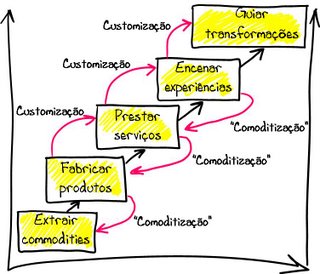Ontem numa conversa por Skype com o meu parceiro das conversas oxigenadoras apanhei várias pérolas. Uma dessas últimas pérolas foi acerca da beleza das coisas pequenas.
Queremos fazer cortes radicais com o passado, queremos criar momentos fundacionais, e o meu parceiro escolhe outro caminho:
começar com coisas pequenas, um bocadinho todos os dias, uma melhoria por semana, e ir documentando o confronto entre o antes e o depois.
Um bocadinho todos os dias cria rotina.
Um bocadinho todos os dias, mais o confronto entre o antes e o depois, cria a sensação de recompensa que motiva a continuar a rotina.
Outra das pérolas foi acerca da segurança. Há anos que o meu parceiro martela a tecla da segurança, para ele
a segurança está na raiz de tudo o resto nas empresas. Quando um trabalhador na altura do começo da preocupação com o surto de Coronavirus perguntou:
- Como é que eu me posso sentir em segurança?
E a resposta foi magistral e plena de ensinamento profundo:
- A segurança está em ti. A segurança que vais ter é a que vais fazer. (Muito antes de haver circular para as empresas a exigir plano de contingência, já ele existia na sua empresa, já as pessoas estavam a par de boas práticas de protecção)
O que é que é mais importante para um trabalhador neste momento? A sua segurança!
Quantas empresas estão a aproveitar a oportunidade do Coronavirus? Como ele escreveu há tempos, o importante é fazer da empresa um local mais seguro do que a própria casa de cada um. Como?
Através do espírito crítico e criativo das pessoas da empresa num esforço de aprendizagem colaborativa.
De tarde, no meu escritório (é esquisito porque nesta altura parece que há ainda mais trabalho, as pessoas em teletrabalho acabam por concentrar-se naquilo que envio e puxam muito mais por mim, quando normalmente é ao contrário) olhei para uma prateleira, mirei um livro e agarrei-o.
Sim, "
The Dance of Change" coordenado por Peter Senge.
E comecei a ler o capítulo II seguindo os sublinhados feitos em 2006 (?). Estejam atentos ao paralelismo das cores acima com as cores abaixo:
"All living systems start small.
...
Once we surrender the myth that a "heroic CEO creates change", we understand that all great things have small beginnings - and we begin thinking naturally in terms of "pilot groups."
...
Thus, for at least the first several months, more likely than not, most of the action in a profound change initiative will take place at a pilot group level.
...
Nothing can grow in a self-sustaining way unless there are reinforcing processes underlying its growth.
...
We believe there are at least three fundamental reinforcing processe that sustain profound change by building upon each other, only one of which is concerned explicitly with improved business results:
- enhancing personal results
- developing networks of committed people; and
- improving business results.
To understand these reinforcing processes, it is easiest to start where most leaders start: investing themselves in profound change initiatives.
...
[Moi ici: Primeiro ciclo autocatalítico] R1: "Because it matters" (personal results)"I believe that people do have passion to produce resultssay," says consultant and writer Fred Kofman, "but not business results. Sure, they care about business results, but they really have passion for the quality of their life. Once they experience living their lives more closely to the way they really want to live, that passion will emerge."
.
We have consistently found that direct personal benefits constitute the first source of reinforcing energy for sustaining deep change. It is inherently satisfying to work in a team where people trust one another and feel aligned to a sense of common purpose.

Indeed, people's enthusiasm and willingness to commit themselves naturally increase when they realize personal results from a change initiative; this in turn reinforces their investment, and leads to further learning (the R1 loop in the diagram). If this reinforcing process is not activated, a significant force for building momentum is lost, one that reinforces each of the other forces. That is why most change initiatives fail to activate this source of reinforcing growth; they are not based on harnessing learning capabilities.
...
[Moi ici: Segundo ciclo autocatalítico] R2: "Because my colleagues take it seriously" (networks of committed people)

Studies of the ways in which innovations diffuse within large organizations have consistently pointed to the importance of informal networks and professional communities. These networks, much more than the formal management structures, seem vital to how people learn about new ideas, coach one another in trying them out, and share practical tips and lessons over time. "Organizations are webs of participation," ... "Change the participation and you change the organization."
...
"Communities of Practice" exist throughout all organizations: networks of people who rely on one another in the execution of real work.
.
They are bound together by "a common sense of purpose and a real need to know what each other knows." Seely Brown regards them as "the critical building block of a knowledge-based company.
.
Such informal networks are almost always superior to hierarchical channels for spreading new innovations.
...
[Moi ici: Terceiro ciclo autocatalítico] R3: "Because it works" (business results)

How do enhanced learning capabilities lead to greater business results? Primarly, through new business practices.
...
Setting the "Growth processes of profound change" into motion
Each of these processes operates simultaneously, generating a distinct set of forces that can sustain growth, albeit with different speeds due to the different delays in each process. They are interdependent, in that changes in one can strengthen the effects of others - such as when enhanced business results further increases enthusiasm arising from personal results, or when either type of results makes people in informal networks more interested in their own learning initiatives."
Interessante como as duas abordagens se interligam.

%2016.58.jpeg)






















%2006.21.jpeg)












